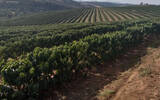What is the Chaka batch of Ethiopia's Guixia Village Estate?
Ethiopia is recognized as the birthplace of coffee, and coffee has also become the country's main source of foreign exchange earnings. More than 4 million farmers in Ethiopia produce coffee, mainly forest coffee and courtyard coffee (pastoral coffee), and only about 10% are coffee estates.
When it comes to Esse's coffee estate, the most famous is the Rose Summer Village estate Gesha Village Coffee Estate, located in the western Bench Maji region. Unlike most Ethiopian farms, the estate is not a small farm, but a 500-hectare farm with its own coffee processing plant and laboratory, mainly growing and exporting rose varieties.
Moreover, the grading of Guixia Village Manor is different from that of Ethiopia. The coffee grading of Rosa Village Manor draws lessons from that of some well-known estates in Panama. It is divided into five grades: bidding batch, gold bid batch, red mark batch, green mark batch and Chaka batch. Among these batches, the gold and red standard batches are the most well-known and the price is relatively high, while the most cost-effective batch is the Chaka batch (Chaka). What is so special about this batch?
At present, Ruoxia Village Manor has 8 plots, which grow three coffee varieties: Rosa 1931 (Gesha1931), Gori Gesha (Gori Gesha) and Illubabor Forest 1974 (Yilu).
Among them, the rose summer 1931 variety is discovered by the landowner Adam Overton and his wife when they came to the place named Gesha Village in Banchi Maggie village in the early days of establishing the rose summer village. This variety is very similar to the Panamanian rose variety in plant appearance, cup-tested flavor and gene alignment, so it is named "Rosa 1931" (the rose variety was first discovered in 1931).
After the establishment of the village, the landowner found a kind of coffee very similar to Rosa in the Gori Forest, 12 miles away from the manor. At that time, he took it back to the manor for planting and named it "Gori Roxia Gori Gesha".
The variety Illubabor Forest 1974 was discovered by the Ethiopian Coffee Research Center during an investigation in the Illubabor Forest in 1974. It is an antibody variety and is currently grown only in the estate of Rosa Village.
In the classification of Ruoxia Village manor, competitive bidding batches, gold bid batches, red mark batches and green mark batches are all harvested single varieties from a single plot, with detailed traceability information. The Chaka batch is a rosy summer mix launched by Rose Xia Village.
It is all the land of the whole manor, which is a mixture of three varieties: Rosa 1931, Gori Roxia and Iru Gbagbo 1974, accounting for 70% of the annual coffee production of the manor. It can be said that the Rose Xia Village Manor does not emphasize subdivision, high performance-to-price ratio, and can be a large and stable supply of high-quality batches.
And "Chaka Chaka" means "forest" in the ancient Ethiopian language, because the Rosa Village Manor itself is also built on the edge of the primeval forest on the Ethiopian plateau, which means that the batch is taken from the forest of the entire Rose Xia Village Manor.
For more information about coffee producing areas, please scan the code directly and follow: coffee comments.
Long press the QR code to follow:
TRANSLATE with
XEnglishArabicHebrewPolishBulgarianHindiPortugueseCatalanHmong DawRomanianChinese SimplifiedHungarianRussianChinese TraditionalIndonesianSlovakCzechItalianSlovenianDanishJapaneseSpanishDutchKlingonSwedishEnglishKoreanThaiEstonianLatvianTurkishFinnishLithuanianUkrainianFrenchMalayUrduGermanMalteseVietnameseGreekNorwegianWelshHaitian CreolePersian
TRANSLATE with
COPY THE URL BELOW
BackEMBED THE SNIPPET BELOW IN YOUR SITE Bing Webmaster PortalBack
Important Notice :
前街咖啡 FrontStreet Coffee has moved to new addredd:
FrontStreet Coffee Address: 315,Donghua East Road,GuangZhou
Tel:020 38364473
- Prev

Set a record for a single month! Brazilian coffee exports surge in October
Recently, according to a report issued by the Brazilian Coffee Exporters Council (Cecafé), although logistics problems have persisted, resulting in approximately 2.1 million bags (60 kg/bag) of coffee bean products in Brazil unable to be shipped and exported at the end of September, Brazil's coffee exports in October still hit a record in a single month. in 1
- Next

Popular knowledge of hand-flushing theory: What factors can cause over-extraction and under-extraction of coffee?
When making coffee, everyone should have the same goal, which is how to make it taste good. Although people have different definitions of good drinking, as long as we generally ensure that it is neither extracted nor obviously under-extracted, we naturally know that it is a good cup of coffee. Because of this, yes
Related
- Being chased out of the rain in front of Starbucks?! Store: Sheltering from rain under umbrellas poses a safety hazard
- The white moonlight has changed?! Lucky launches "Big Winter Pear American"
- Hand-brewed coffee three-stage method, high-sweet and universal brewing method to share! What does the high sweet water level of hand-brewed coffee mean?
- What is the difference between raw, refined and full espresso coffee? How to extract espresso and taste good?
- A complete list of coffee bean names and their meanings! What is Yejia Shefi coffee? Where is Mantelin coffee?
- What grade does Arida Manor Kaduai coffee beans belong to? What treatment is Arida ASD slow anaerobic sun exposure?
- The milk tea cup becomes smaller?! Overlord Tea Girl launches a new "Return to Yunnan" series
- Accused of selling counterfeit and high-priced coffee beans! Well-known boutique coffee brand "Oukelao" bowed and apologized!
- How to make espresso dumplings? Can I eat coffee and glutinous rice balls together?
- Save the unformed and stagnant powder cakes in one second! What is the problem with stagnant water in the powder bowl of the espresso machine?

